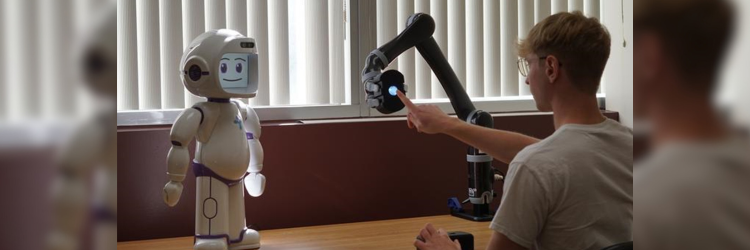
Most of us know family members or friends who have had a stroke. More than 15 million people globally experience strokes each year, with 75% of them experiencing impairment, weakness, and even paralysis in their arms and hands. Typically, the survivors rely on a stronger arm to perform daily tasks, even though the usefulness of the weaker arm could improve. The challenge is knowing how much the patient uses that weaker arm outside the clinic setting. Getting an accurate reading on spontaneous use is especially difficult.
USC researchers announced a robot system designed to help stroke survivors track their recovery. The team is trying to assess how much physical therapy performance transfers to their day-to-day life. The tool collects precise data on how people use their arms spontaneously. The first-of-its-kind method is published in Science Robotics.
The use of a robotic arm tracks 3D spatial information and machine learning techniques to process data, generating an “arm nonuse” metric to help clinicians accurately assess a patient’s rehabilitation progress. A socially assistive robot (SAR) provides instructions and encouragement throughout the challenge. The team recruited 14 participants who were right-hand dominant before the stroke. The participant placed their hands on the device’s home position, a 3D-printed box with touch sensors; the SAR gave positive feedback, while the robot arm moved a button to different target locations in front of the participant (100 locations in total). The “reaching trial” starts when the button lights up and the robot cues the participant to move.
Initially, participants are directed to reach for the button using either hand, mirroring everyday use. Then, they are instructed to use the stroke-affected arm only, which reflects performance in physiotherapy or other clinical settings. Machine learning enables the team to analyze three measurements to determine a metric for arm nonuse: arm use probability, time to reach, and successful reach. A noticeable performance difference between the phases suggests nonuse of the affected arm. Since there’s a time limit to use the button, they must act quickly, which helps measure gut reaction.
The method is reliable across repeated sessions, and participants say it is simple to use. Most importantly, it provides healthcare professionals with a way to track a patient’s stroke recovery.
The technology addresses many issues encountered with traditional methods of assessment, which “require the patient not to know they’re being tested,” and are based on the tester’s observation, leaving greater room for error.
